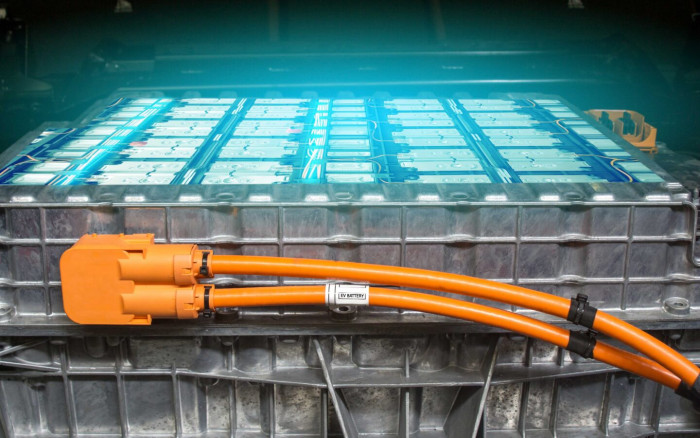NERSC Assists in Search for More Sustainable EV Batteries
Breakthrough battery technology could ramp up domestic supply chain of critical minerals driving clean energy transition
September 11, 2023
By Theresa Duque
Contact: media@lbl.gov
Key Takeaways
- A new battery material called disordered rock salt (DRX) could pave the way for replacing gasoline vehicles with electric vehicles at a faster rate.
- DRX cathodes could provide lithium-ion batteries with higher energy density than conventional cathodes made of nickel and cobalt and make batteries for electric vehicles more sustainable.
- New battery materials typically take decades to commercialize, but researchers hope to demonstrate commercial-ready DRX cathodes in just a few years.
A consortium of the nation’s best battery scientists, led by Lawrence Berkeley National Laboratory (Berkeley Lab), will accelerate the commercialization of a new family of battery cathode materials called DRX or “disordered rock salt.”
DRX cathodes could provide batteries with higher energy density than conventional lithium-ion battery cathodes made of nickel and cobalt, two metals that are in critically short supply.

An electric vehicle lithium-ion battery pack. Lithium-ion batteries could get a significant boost in energy density from disordered rock salt (DRX), a versatile battery material that can be made with almost any transition metal instead of nickel and cobalt. (Credit: Smile Fight/Shutterstock)
The U.S. Department of Energy (DOE) has made it a priority to find ways to reduce or eliminate the use of cobalt in batteries. In support of that initiative, the DRX Consortium is focused on making DRX cathodes made of manganese or titanium, which are both more abundant and cheaper than nickel or cobalt. Lithium batteries made with DRX cathodes could safeguard the automobile industry and, therefore, consumers from higher prices spurred by supply constraints.
“DRX cathodes can be made with almost any transition metal instead of nickel and cobalt. That versatility is key if we want to replace gasoline vehicles with electric vehicles,” said principal investigator Gerbrand Ceder. The Berkeley Lab faculty senior scientist and UC Berkeley professor of materials science and engineering is co-leading the DRX Consortium with fellow battery scientist Guoying Chen at Berkeley Lab.
Formed last fall, the DRX Consortium – which includes a team of approximately 50 scientists from Berkeley Lab, SLAC National Accelerator Laboratory, Pacific Northwest National Laboratory, Argonne National Laboratory, Oak Ridge National Laboratory, and the University of California at Santa Barbara – was awarded $20 million from the Vehicle Technologies Office in DOE’s Office of Energy Efficiency and Renewable Energy. The funding – allocated in $5 million yearly increments through 2025 – will allow the consortium to develop DRX battery cathodes that could perform just as well, if not better, than the NMC (nickel-manganese-cobalt) cathodes used in today’s lithium-ion batteries.
“DRX offers more sustainable, more abundant, and cheaper mineral sources for battery cathodes,” Ceder said. “The lithium-ion battery is a really good energy storage technology, but to stay relevant, it will need to grow toward higher production of multiple terawatt-hours per year. Without DRX, lithium-ion batteries would require enormous amounts of nickel and cobalt if we stay with current technologies.”
“DRX could be the go-to material for battery cathodes,” said Chen. “We already have the advantage of cost and resources. Now all we have to do is improve performance.”
Decarbonizing Transportation with DRX
DRX is still a very young technology – Ceder and his team developed DRX just less than 10 years ago, in 2014, as a response to a rapidly growing lithium-ion battery industry. New battery technologies typically take 20 to 30 years to mature. But DRX is on an unusually fast track toward commercialization.
Ceder and Chen demonstrated DRX’s potential during a four-year program called the “Deep Dive,” which was also funded by the DOE Vehicle Technologies Office. That program ended in 2022, and the consortium formed soon after with the goal of demonstrating commercial-ready DRX cathodes in less than five years.
This urgency comes in the midst of a clean energy transition. The United States aims to make half of all new cars sold in 2030 zero-emissions vehicles, including battery electric, plug-in hybrid electric, or fuel cell electric vehicles. In California, all new cars must be zero-emission vehicles beginning in 2035.
To achieve this ambitious goal, Ceder and Chen formed the DRX Consortium, enlisting top battery scientists from across the country and the national lab system to help.
Researchers at the Department of Energy’s National Energy Research Scientific Computing Center (NERSC) will help the team narrow down the best combination of manganese and titanium through computer modeling. Researchers from Oak Ridge National Laboratory and Argonne National Laboratory will work on chemical synthesis and scale up the materials for industry. New DRX-compatible electrolytes will be developed at Pacific Northwest National Laboratory. Researchers from Berkeley Lab’s Molecular Foundry, SLAC National Accelerator Laboratory, and UC Santa Barbara will assist with the characterization of materials.
About NERSC and Berkeley Lab
The National Energy Research Scientific Computing Center (NERSC) is a U.S. Department of Energy Office of Science User Facility that serves as the primary high performance computing center for scientific research sponsored by the Office of Science. Located at Lawrence Berkeley National Laboratory, NERSC serves almost 10,000 scientists at national laboratories and universities researching a wide range of problems in climate, fusion energy, materials science, physics, chemistry, computational biology, and other disciplines. Berkeley Lab is a DOE national laboratory located in Berkeley, California. It conducts unclassified scientific research and is managed by the University of California for the U.S. Department of Energy. »Learn more about computing sciences at Berkeley Lab.







